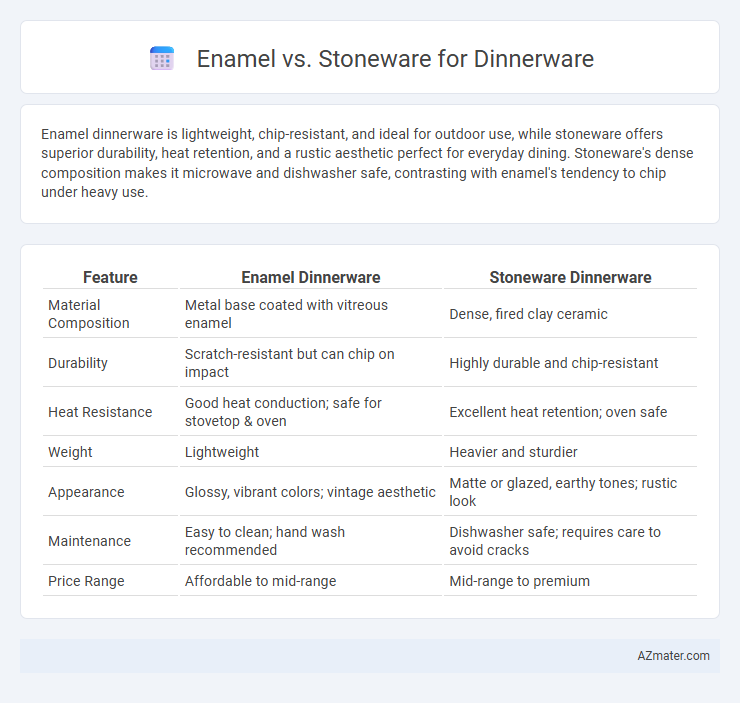Enamel dinnerware is lightweight, chip-resistant, and ideal for outdoor use, while stoneware offers superior durability, heat retention, and a rustic aesthetic perfect for everyday dining. Stoneware's dense composition makes it microwave and dishwasher safe, contrasting with enamel's tendency to chip under heavy use.
Table of Comparison
| Feature | Enamel Dinnerware | Stoneware Dinnerware |
|---|---|---|
| Material Composition | Metal base coated with vitreous enamel | Dense, fired clay ceramic |
| Durability | Scratch-resistant but can chip on impact | Highly durable and chip-resistant |
| Heat Resistance | Good heat conduction; safe for stovetop & oven | Excellent heat retention; oven safe |
| Weight | Lightweight | Heavier and sturdier |
| Appearance | Glossy, vibrant colors; vintage aesthetic | Matte or glazed, earthy tones; rustic look |
| Maintenance | Easy to clean; hand wash recommended | Dishwasher safe; requires care to avoid cracks |
| Price Range | Affordable to mid-range | Mid-range to premium |
Introduction to Enamel and Stoneware Dinnerware
Enamel dinnerware features a durable, non-porous coating made from fused powdered glass on metal, offering resistance to stains and heat, making it ideal for outdoor and everyday use. Stoneware dinnerware consists of dense, fired clay that is chip-resistant and retains heat well, providing a rustic aesthetic and solid durability for formal dining. Both materials balance practicality and style, but enamel excels in lightweight portability while stoneware delivers a heavier, classic feel.
What is Enamel Dinnerware?
Enamel dinnerware consists of metal, usually steel or cast iron, coated with a smooth, durable layer of vitreous enamel that resists scratches, stains, and corrosion. This type of dinnerware is lightweight, non-reactive, and ideal for both indoor and outdoor use due to its heat resistance and easy-to-clean surface. Enamelware offers vibrant colors and a classic, timeless appearance, making it popular for casual dining and camping.
What is Stoneware Dinnerware?
Stoneware dinnerware is a type of pottery made from dense, non-porous clay fired at high temperatures, resulting in a durable, chip-resistant finish. It features a naturally earthy texture with glazed surfaces that offer both practicality and aesthetic appeal. Stoneware is valued for its heat retention, making it ideal for serving hot meals while maintaining a rustic, handcrafted look.
Durability: Enamel vs Stoneware
Enamel dinnerware features a durable, chip-resistant surface made by fusing powdered glass to metal at high temperatures, providing excellent resistance to scratches and heat. Stoneware is fired at high temperatures, resulting in a dense, robust ceramic that resists chipping and cracking under regular use but can be more prone to damage from impacts compared to enamel. Both materials offer strong durability, with enamel excelling in impact resistance and stoneware providing superior thermal retention and sturdiness for everyday dining.
Aesthetics and Design Options
Enamel dinnerware offers a sleek, vintage-inspired look with vibrant colors and glossy finishes that enhance table settings with a timeless charm. Stoneware provides a rustic, earthy aesthetic characterized by natural textures, muted tones, and handcrafted variations that add unique visual depth. Both materials allow diverse design options, but enamel excels in bold patterns and smooth surfaces, while stoneware emphasizes organic shapes and artisanal appeal.
Heat Retention and Performance
Stoneware offers superior heat retention due to its dense, non-porous structure, ensuring food stays warm longer during meals. Enamel-coated dinnerware provides faster heating and cooling, making it ideal for serving dishes that require temperature changes but less effective at maintaining warmth. Performance-wise, stoneware is more durable for heat-intensive cooking and serving, while enamel excels in lightweight versatility and quick temperature regulation.
Safety and Food Compatibility
Enamel dinnerware features a smooth, non-porous coating of powdered glass fused to metal, ensuring resistance to staining, rust, and chemical leaching, which makes it highly safe and food-compatible. Stoneware, made from dense, fired clay, offers a naturally non-reactive surface that resists scratches and does not absorb food particles or odors, promoting safe food contact. Both materials are lead-free options when certified, but enamel may chip under heavy impact, potentially exposing the metal base, whereas stoneware's durability depends on glaze quality and firing process for optimal food safety.
Ease of Cleaning and Maintenance
Enamel dinnerware features a smooth, non-porous surface that resists stains and is dishwasher safe, making it exceptionally easy to clean and maintain. Stoneware, while durable, has a slightly more porous surface that can absorb oils and stains, requiring more careful hand washing and occasional sealing to preserve its appearance. Choosing enamel ensures low-maintenance cleaning, whereas stoneware demands more attentive care to avoid discoloration and maintain longevity.
Cost Comparison: Enamel vs Stoneware
Enamel dinnerware typically costs less than stoneware due to its lightweight material and simpler manufacturing process, with prices ranging from $5 to $15 per piece compared to stoneware's $10 to $30 per piece. Stoneware, made from dense clay and fired at higher temperatures, offers greater durability and a premium feel, which often justifies the higher price point. While enamel is more budget-friendly and resistant to chipping, stoneware provides better heat retention and longevity, factors that influence overall value beyond the initial purchase cost.
Choosing the Best Dinnerware for Your Needs
Choosing between enamel and stoneware dinnerware depends on durability, aesthetic, and use. Enamelware offers lightweight, chip-resistant options ideal for outdoor and casual dining, while stoneware provides a heavier, more elegant finish suited for formal settings and microwave use. Consider your lifestyle, maintenance preferences, and desired style to select dinnerware that balances practicality with beauty.

Infographic: Enamel vs Stoneware for Dinnerware
 azmater.com
azmater.com